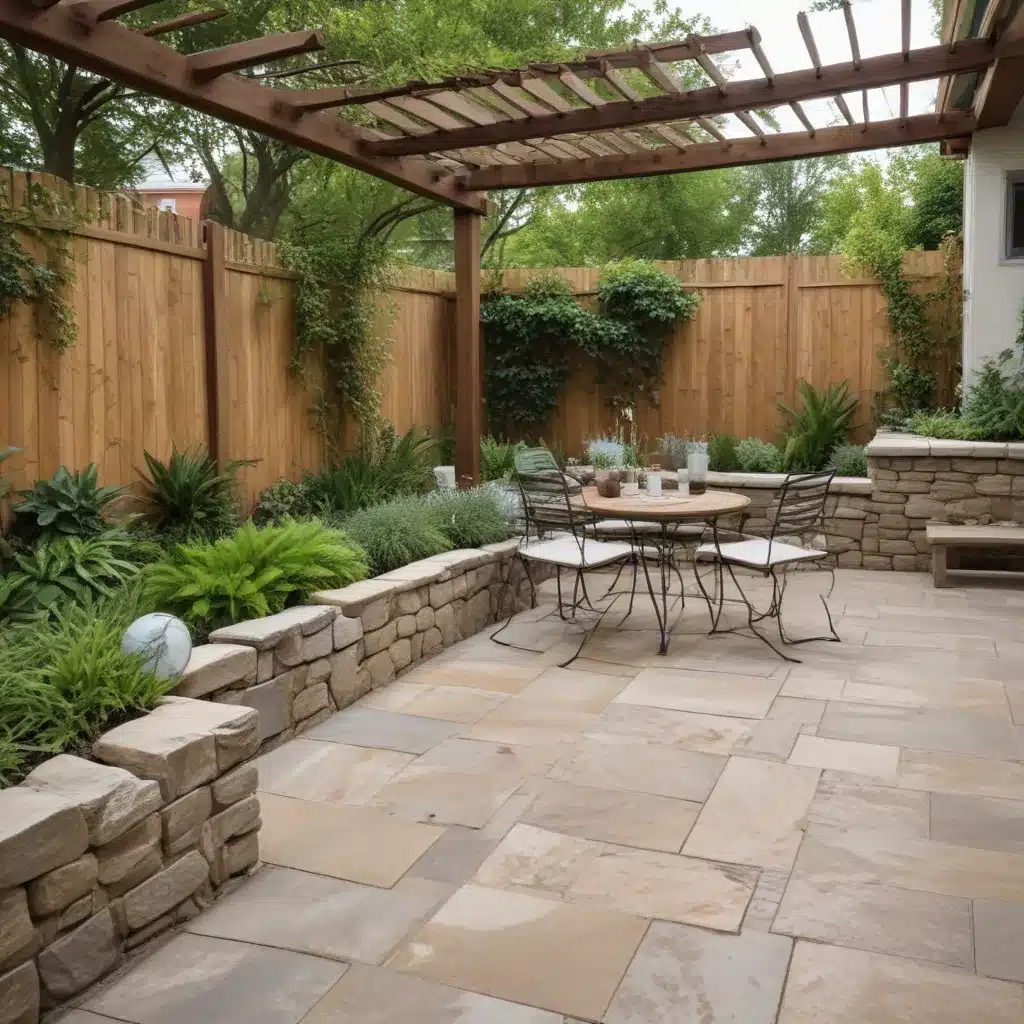
As an experienced outdoor living consultant, I’ve had the pleasure of guiding homeowners through the process of transforming their backyards into sustainable oases. One of the most crucial elements in this journey is the selection of patio paving materials – a decision that not only impacts the aesthetics but also the long-term environmental footprint of your outdoor space.
Permeable Paving: Letting Nature Breathe
In today’s climate-conscious world, permeable paving has emerged as a game-changer in the realm of eco-friendly patio options. These innovative pavers are designed to allow water to seep through the surface and into the ground below, reducing runoff and replenishing the groundwater table. Made from materials like concrete, plastic, or natural stone, permeable pavers help mitigate flooding, control water pollution, and minimize soil erosion – all while maintaining a sleek and modern appearance.
Homeowners who opt for permeable paving not only contribute to water conservation efforts but also benefit from improved drainage and reduced pooling during heavy rainfall. This feature is particularly valuable in areas prone to flooding or with high water tables, making it an excellent choice for sustainable backyard design.
Natural Stone Pavers: Timeless Elegance, Minimal Impact
For those seeking a more classic, natural look, natural stone pavers offer a stunning and eco-friendly alternative. These materials, often reclaimed from old buildings or construction sites, prevent them from ending up in landfills while adding a unique, rustic charm to your outdoor living space.
Beyond their aesthetic appeal, natural stone pavers are highly durable and long-lasting, making them a wise investment for homeowners looking to minimize their environmental impact. Additionally, the use of reclaimed materials reduces the demand for newly extracted resources, further contributing to the sustainability of your patio project.
Embracing Recycled Materials: A Second Life for Paving
In the pursuit of eco-friendly patio solutions, reclaimed materials have emerged as a standout option. Homeowners can now choose from a variety of repurposed materials, such as bricks, stones, or even broken concrete, to create a visually stunning and environmentally responsible patio.
Not only do these recycled paving options divert waste from landfills, but they also often require less energy-intensive manufacturing processes compared to traditional paving materials. By embracing the second life of these materials, you can contribute to a more circular economy and leave a lighter footprint on the planet.
Outdoor Design Ideas: Blending Sustainability and Style
As an outdoor living consultant, I’ve witnessed the growing demand for patio designs that seamlessly integrate sustainability and aesthetic appeal. One emerging trend is the minimalist aesthetic, where clean lines, neutral tones, and a focus on natural materials create a serene and calming atmosphere.
Another popular approach is the integration of greenery, where patio pavers are strategically interspersed with lush, low-maintenance plants. This not only adds a touch of natural beauty but also helps to mitigate the urban heat island effect, cool the surrounding air, and provide valuable habitat for local wildlife.
For homeowners seeking to maximize the functionality of their outdoor living spaces, multifunctional designs have become increasingly popular. This might involve incorporating permeable pavers that double as walkways and water management systems, or creating versatile spaces that can accommodate a range of activities, from dining to relaxation.
Installation Techniques: Laying the Foundation for Sustainability
Achieving a truly sustainable patio doesn’t just depend on the choice of materials – the installation techniques employed also play a crucial role. Proper site preparation, for instance, ensures that the underlying soil and drainage systems are optimized to support the longevity and performance of the paving materials.
When it comes to the substructure, sustainable options like porous concrete or crushed stone can further enhance the environmental benefits of your patio. These materials allow water to percolate into the ground, reducing runoff and minimizing the strain on local stormwater management systems.
Throughout the installation process, environmentally-friendly practices should be a top priority. This might involve the use of energy-efficient equipment, the recycling of excess materials, and the incorporation of renewable energy sources to power the installation.
Maintenance Guidelines: Keeping Your Patio Eco-Friendly
Maintaining the long-term sustainability of your patio doesn’t end with the installation – it’s an ongoing process that requires diligent care and attention. Regular cleaning and care of the paving materials, using eco-friendly products and methods, can help preserve their appearance and functionality while minimizing the use of harmful chemicals.
When it comes to longevity and durability, the choice of paving materials plays a crucial role. Opt for options that are not only visually appealing but also built to withstand the test of time, reducing the need for frequent replacements and the associated environmental impact.
For eco-friendly upkeep, consider strategies like using natural weed-control methods, avoiding harsh chemicals, and incorporating water-conserving practices into your routine maintenance. By adopting a sustainable mindset, you can ensure that your patio remains a haven of environmental responsibility for years to come.
Cost Comparisons: Investing in the Future
While the initial investment for eco-friendly patio paving may be higher than traditional options, the long-term cost savings and environmental benefits often make it a wise choice for homeowners. By factoring in the reduced maintenance requirements, extended lifespan, and potential incentives or rebates, the true value of a sustainable patio becomes increasingly clear.
Government programs, tax credits, and utility rebates are just a few examples of the financial incentives available to homeowners who opt for eco-friendly paving solutions. These initiatives aim to encourage sustainable practices and offset the initial costs, making it more accessible for homeowners to transform their outdoor spaces into environmentally responsible havens.
As an outdoor living consultant, I’ve seen firsthand the transformative power of eco-friendly patio paving. By embracing innovative materials, thoughtful design, and sustainable installation techniques, homeowners can create backyard oases that not only reflect their personal style but also contribute to the health of our planet. So, let’s pave the way to a more sustainable future, one patio at a time.

